
Background information
Qualcomm Snapdragon X Plus and Elite – revolution for the laptop world?
by Martin Jud
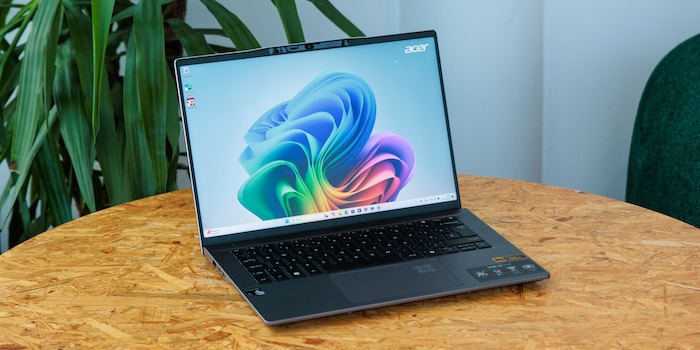
The Swift Go 14 AI is Acer’s first notebook with a Qualcomm ARM chip. With the Snapdragon X Plus, however, it isn’t the most powerful variant. However, the computer does show when the AI is active.
The Snapdragon X Plus is positioned below Qualcomm’s Elite models, but is apparently just as good in terms of AI performance. Acer’s built it into a notebook with an AI indicator on the touchpad, long battery life and fewer ports than the Copilot button Plus PCs in the same series with chips from Intel or AMD.
AI is a must for new notebooks. Acer’s the first manufacturer to make it visible. There’s a pattern on the touchpad of the Swift Go 14 AI that lights up as soon as the Snapdragon chip’s NPU is activated.
The AI Lightning Touchpad clearly shows when the artificial intelligence is active. There were no surprises. The display lit up for the programs and calculations I expected it to. However, this was less frequent than I’d thought, so many applications still work without the NPU.
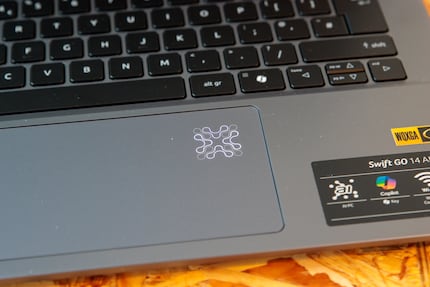
Apart from the AI light, it’s a normal touchpad that works reliably. It recognises my fingers without any problems and allows me to move the cursor accurately. The touchpad has clear pressure points in the lower area, which makes clicking comfortable.
The keyboard on the Swift Go 14 AI has a backlight. Its pressure points are easy to feel, but I’d prefer them to be even crisper. In addition to the now-standard Copilot key that activates Microsoft’s AI, a key with the Acer logo next to the F keys stands out. I use this to start AcerSense – a bundle of system settings that the manufacturer claims are easier for laypeople than Windows settings. The fingerprint sensor in the on/off button works perfectly.
Acer’s equipped the Swift Go 14 AI with a 14.5-inch IPS display. With an aspect ratio of 16:10, there are 2560 × 1600 pixels. This is easily enough for a sharp display showing the smallest details. The refresh rate also ensures smooth fast animations or content.
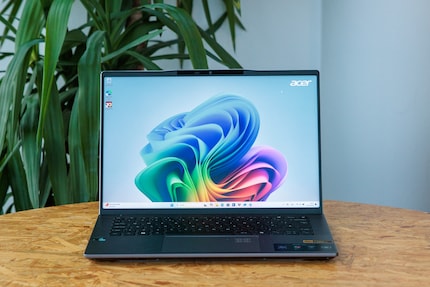
I was delighted to measure a brightness of up to 395 nits – higher than the manufacturer’s specification of 350 nits. This means that the display is perfectly suitable for indoor use. Outdoors, I can only see content clearly in the shade.
In terms of colour space coverage, only the measured value of 97.7 per cent for the sRGB colour space is convincing – although even that isn’t quite perfect. If you need exact reproduction of Adobe RGB or DCI-P3, go for a different notebook. The Swift Go 14 AI only achieves 71.3 and 73.9 per cent for them respectively.
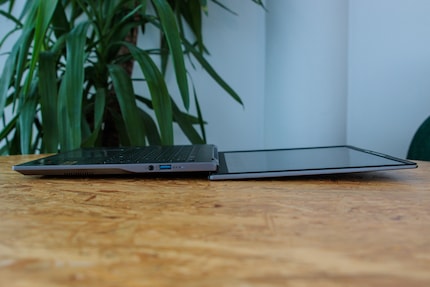
The Swift Go 14 AI contains the Snapdragon X Plus – the X1P-42-100 to be precise. In the Plus range, however, the exact model name is less important. Unlike at the Elite level, there’s only one chipset with ten processing cores. The 8-core model of the X Plus presented at IFA 2024 clearly identifies Qualcomm. With the presentation of the Snapdragon X at CES 2025, the Plus chipset has finally become a mid-range model. The NPU – important for AI functions – should deliver just as much performance as the Elite chips.
That’s why I’m comparing the Acer notebook with the Lenovo Yoga Slim 7x (Snapdragon X Elite X1E-78-100) and the Microsoft Surface Pro (Snapdragon X Elite X1E-80-100). The Adreno GPU integrated in the three Snapdragon chips is said to deliver identical performance.
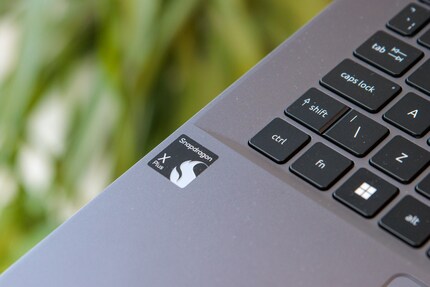
I’m also adding in the Asus Zenbook S16 (Ryzen AI 9 HX 370) and the Samsung Galaxy Book5 Pro 360 (Core Ultra 5 226V) to compare with the AMD and Intel chips. While the Intel chip is a mid-range model, the AMD chip is top of the range.
The Swift Go 14 AI also has 16 gigabytes of RAM. Same applies to the Microsoft and Samsung notebooks. The Asus and Lenovo laptops each have 32 gigabytes.
As expected, the Snapdragon X Plus’ CPU performance in multi-core mode is lower than that of the chipset’s Elite variants. The Swift Go 14 AI offers 20-25 per cent less performance in comparison. However, the notebook has enough power for typical office applications. The AMD chip, which is also ranked higher, only slightly outperforms the Snapdragons in the overall ranking. In single-core mode – less relevant today – there’s less of a difference between the five chipsets.
The Snapdragon chips are known for their comparatively low graphics performance. However, the X Plus’ GPU performs significantly worse even just compared to the X Elite. Acer’s not promoting the Swift Go 14 AI for gaming anyway. If you need strong GPU performance, pick a notebook with Intel or AMD chips.
I’m using Geekbench AI to try to get a feel for the NPU’s performance. In the overall ranking, the Snapdragon X Plus is only slightly behind its Elite counterparts and outperforms the mid-range chip from Intel. The AMD chip’s best score is based on individual values that are completely different from those of the other processors. Despite in-depth discussions in the editorial team and searching half the internet, I still haven’t found a good explanation for the differences between Single Precision Score, Half Precision Score and Quantized Score. If anyone can help – including for future tests – please let me know in the comments.
Acer’s equipped the Swift Go 14 AI with a 75 Wh battery. With this, it achieves a very good 18 hours and eight minutes in PCMark 10’s Video battery test. The Office battery test doesn’t currently work with ARM chips. Of the comparison devices, only the Galaxy Book5 Pro 360 with its Intel chipset and a similarly large battery is better.
The Zenbook with the AMD chip has an even larger battery, but its battery life is significantly worse. The shorter runtimes of the other two Snapdragon notebooks can be explained at least in part by lower battery capacities.
The design hasn’t changed much compared to the previous model, the Swift Go 14 AI. Visually, the most noticeable thing is the darker colour. Instead of silver, it’s now called «iron» and still looks metallic. The finish on the aluminium housing is still flawless.
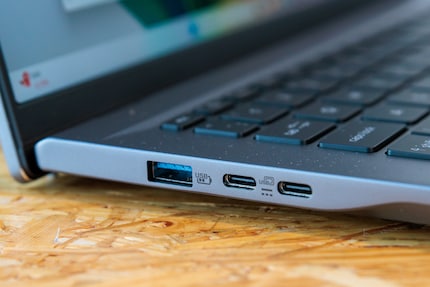
One negative thing I noticed was that Acer’s removed the HDMI port and the microSD card reader. However, this seems to be due to the Snapdragon chip. The Swift Go 14 with its AMD chipset has an HDMI port and the Intel version of the notebook also has a card reader. This leaves the Swift Go 14 AI we tested with two USB 4 ports (USB-C) and two USB 3.2 Type-A sockets as well as a 3.5-mm headphone jack.
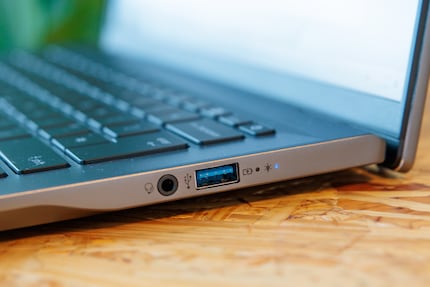
The Acer Swift 14 Go AI offers the full AI performance of Qualcomm’s Snapdragon chips. The X Plus is slightly cheaper, but compromises on CPU and GPU performance. However, it has enough power for office applications and everyday things like streaming, surfing and the like. It’s also very durable with a long battery life.
AI light is a nice gimmick that makes what it does more tangible. The display on the Swift Go 14 AI is usable, but only good in the sRGB colour space. The notebook is handy, well made and has a comfortable keyboard and touchpad.
The weak graphics performance and lack of an HDMI port are negatives. However, if AI performance isn’t important to you, you can find cheaper notebooks for everyday, personal use.
Pro
Contra
As a primary school pupil, I used to sit in a friend's living room with many of my classmates to play the Super NES. Now I get my hands on the latest technology and test it for you. In recent years at Curved, Computer Bild and Netzwelt, now at Digitec and Galaxus.

Product test
by Jan Johannsen

Product test
by Martin Jud

Product test
by Martin Jud